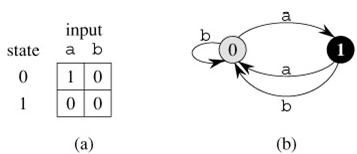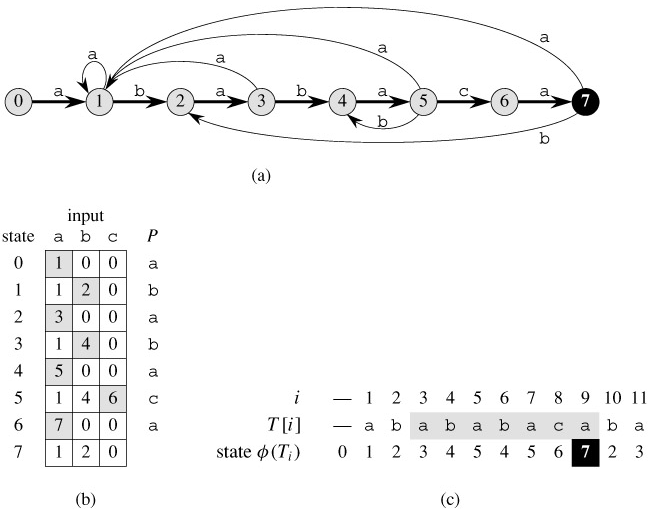SKEDSOFT
String matching with finite automata
Many string-matching algorithms build a finite automaton that scans the text string T for all occurrences of the pattern P. This section presents a method for building such an automaton. These string-matching automata are very efficient: they examine each text character exactly once, taking constant time per text character. The matching time used-after preprocessing the pattern to build the automaton-is therefore Θ(n). The time to build the automaton, however, can be large if Σ is large. Section 32.4 describes a clever way around this problem.
We begin this section with the definition of a finite automaton. We then examine a special string-matching automaton and show how it can be used to find occurrences of a pattern in a text. This discussion includes details on how to simulate the behavior of a string-matching automaton on a given text. Finally, we shall show how to construct the string-matching automaton for a given input pattern.
Finite automata
A finite automaton M is a 5-tuple (Q, q0, A, Σ, δ), where
-
Q is a finite set of states,
-
q0 ∈ Q is the start state,
-
A ⊆ Q is a distinguished set of accepting states,
-
Σ is a finite input alphabet,
-
δ is a function from Q × Σ into Q, called the transition function of M.
The finite automaton begins in state q0 and reads the characters of its input string one at a time. If the automaton is in state q and reads input character a, it moves ("makes a transition") from state q to state δ(q, a). Whenever its current state q is a member of A, the machine M is said to have accepted the string read so far. An input that is not accepted is said to be rejected. Figure 32.6 illustrates these definitions with a simple two-state automaton.

A finite automaton M induces a function φ, called the final-state function, from Σ* to Q such that φ(w) is the state M ends up in after scanning the string w. Thus, M accepts a string w if and only if φ(w) ∈ A. The function φ is defined by the recursive relation
|
φ(ε) |
= |
q0, |
|
φ(wa) |
= |
δ(φ(w), a) for w ∈ Σ*, a ∈ Σ. |
String-matching automata
There is a string-matching automaton for every pattern P; this automaton must be constructed from the pattern in a preprocessing step before it can be used to search the text string. Figure 32.7 illustrates this construction for the pattern P = ababaca. From now on, we shall assume that P is a given fixed patternstring; for brevity, we shall not indicate the dependence upon P in our notation.
 Figure 32.7: (a) A state-transition diagram for the string-matching automaton that accepts all strings ending in the string ababaca. State 0 is the start state, and state 7 (shown blackened) is the only accepting state. A directed edge from state i to state j labeled a represents δ(i, a) = j. The right-going edges forming the "spine" of the automaton, shown heavy in the figure, correspond to successful matches between pattern and input characters. The left-going edges correspond to failing matches. Some edges corresponding to failing matches are not shown; by convention, if a state i has no outgoing edge labeled a for some a ∈ Σ, then δ(i, a) = 0. (b) The corresponding transition function δ, and the pattern string P = ababaca. The entries corresponding to successful matches between pattern and input characters are shown shaded. (c) The operation of the automaton on the text T = abababacaba. Under each text character T [i] is given the state φ(Ti) the automaton is in after processing the prefix Ti. One occurrence of the pattern is found, ending in position 9.
Figure 32.7: (a) A state-transition diagram for the string-matching automaton that accepts all strings ending in the string ababaca. State 0 is the start state, and state 7 (shown blackened) is the only accepting state. A directed edge from state i to state j labeled a represents δ(i, a) = j. The right-going edges forming the "spine" of the automaton, shown heavy in the figure, correspond to successful matches between pattern and input characters. The left-going edges correspond to failing matches. Some edges corresponding to failing matches are not shown; by convention, if a state i has no outgoing edge labeled a for some a ∈ Σ, then δ(i, a) = 0. (b) The corresponding transition function δ, and the pattern string P = ababaca. The entries corresponding to successful matches between pattern and input characters are shown shaded. (c) The operation of the automaton on the text T = abababacaba. Under each text character T [i] is given the state φ(Ti) the automaton is in after processing the prefix Ti. One occurrence of the pattern is found, ending in position 9.